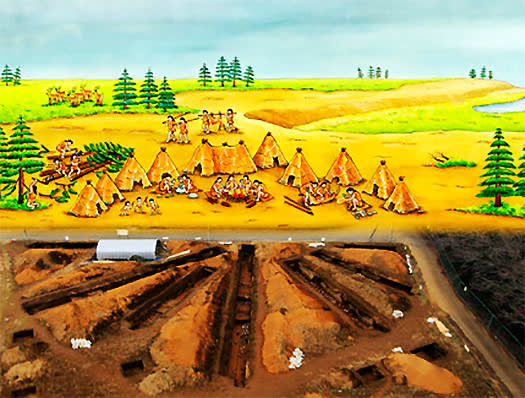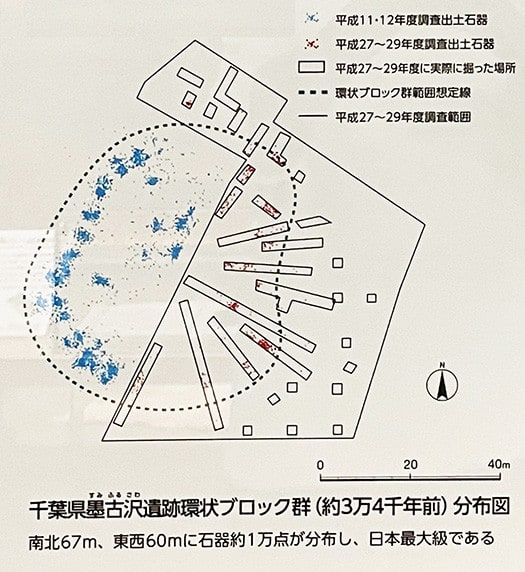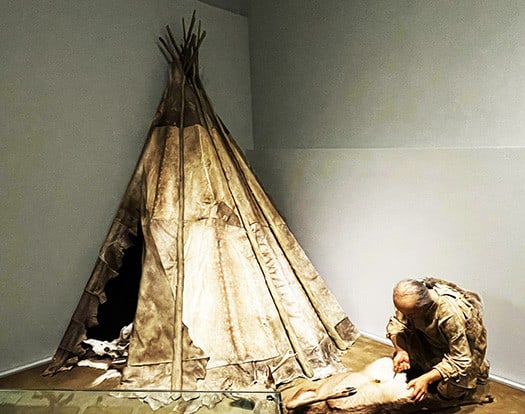




石器時代の住まいのカタチはどんなものだろうか?
こういう直接的な疑問に対して最新の考古・歴史学は探究が及んできている。
図版は千葉県墨古沢遺跡HPと国立歴史民俗博物館・先史展示パネルより。
移動採集生活、という漠然としたライフスタイルが石器時代の暮らしと
これまでの探究結果で示されてきたけれど、
ここでは34,000年前の「千葉県墨古沢遺跡・環状ブロック群」が展示。
以下、パネルに記載されたテキストを書き出してみる。
〜南北67m、東西60mの範囲で石器1万点が集中的に分布し、日本最大級。
サークル状に分布する石器・石屑の集中痕跡が各地で発見されてきて
「環状ブロック群」と呼ばれている。遊動生活を送る狩猟採集民が1箇所に集まった
大規模なムラ、キャンプの跡だったかもしれない。〜
〜大型動物を狩猟するためには複数の集団が集まった「狩りのムラ」という説や
季節的な遊動スケジュールの中で食料などさまざまな生活必需品を交換するために
集まったムラなど諸説があり実態はナゾである。〜
〜旧石器時代には「竪穴住居」は見つかっておらず、
移動可能なテント状の住居が主流だった。キャンプから数キロ圏内で食料を確保。
季節的に移動する動物や季節毎に変化する果樹などの資源に応じて
キャンプ場自体を移動させながら暮らしていた。〜
これまで定住は縄文以降であって石器時代に集落痕跡というのは
こうして実証的な解析結果が示されて初めてそのありようを知った。
人間というのは「人の間」と書くし、必ず類的に生きてきたのだと思いつつ、
縄文以前のライフスタイルは無明の闇の中にあった。
それがこういう遺跡発掘・研究の結果、あきらかになって来ている。
社会的相互扶助なく個人や家族単位程度で独立的に生存し続ける方が
たしかに「理不尽」だと気付かされる。
より大型の動物狩猟を考えれば協働した方が効率は飛躍的に高まるし
テント生活も寄り集まった方が危険への防衛力も高まる。
食糧確保・生産管理という共同体としてこれは「ムラ」と呼んでいいのではないか。
そしてこの時代の住居とはテントだろうし、その骨材は木材であり
面材としては大型動物の皮革だっただろうことが想定される。
より大型の動物ほど、利用可能な皮革は大きい。
展示では男性は狩猟を担当し、女性はその動物皮革を「なめす」仕事を担当していた。
出産育児という定点的役割主体の女性と、狩猟での戦闘行為を期待される男性
という役割分担は蓋然性が高いと思える。
このあとの縄文では主に居住域は海辺・水辺に寄っていく。
日本列島は海に囲まれている有利性があるので
より安定的な動物タンパク源確保策としてこのことはわかりやすい。
漁撈が主体になると食料獲得がより安定したので定住の社会基盤が整った。
そういう結果、大型動物皮革獲得があまり期待できなくなって
住居進化の面を考えると屋根面材は周辺の茅などの植物性素材に変化していった。
さらに定住になると、居住「性能向上」の工夫が始まって
安定した地熱利用が考えられ地面を掘り下げる竪穴に向かったのではないか。
そんな巨視的な「都市と住まいの流れ」が見晴らせるように思われた。
English version⬇
A 34,000 Year Old Mura? Ring Camp 37,000 Years of the Japanese Archipelago - 3]
Empirical analysis of a Stone Age settlement. Traces of existence of social mutual aid. People have lived analogously among people. ...
What did Stone Age dwellings look like?
The latest archaeological and historical studies are exploring these direct questions.
Illustrations are from the website of the Sumikosawa Site, Chiba Prefecture, and the prehistoric exhibition panel at the National Museum of Japanese History.
Although the vague lifestyle of migratory gatherers has been shown to have been a Stone Age way of life, it is not clear how it could have been a prehistoric way of life.
The results of previous research have shown that this was the lifestyle of the Stone Age.
The "Sumikosawa Site, Chiba Prefecture, Circular Block Group" from 34,000 years ago is on display here.
The following is a written description of the text on the panel.
〜The site is one of the largest in Japan, with 10,000 stone tools concentrated in an area measuring 67 m from north to south and 60 m from east to west.
The traces of concentrated stone tools and stone garbage distributed in a circle shape have been found in various places, and are called the "Circle Block Group".
These are called "Circle Block Groups. This may have been the site of a large village or camp where hunter-gatherers who led a nomadic life gathered in one place.
It may have been the remains of a large scale village or camp where hunter-gatherers engaged in a nomadic lifestyle gathered in one place. ~.
~The theory of "hunting villages" where multiple groups of people gathered to hunt large animals, or
to exchange various necessities of life such as food during the seasonal migratory schedule.
The actual situation is a mystery. 〜The actual situation is a mystery.
〜Pit dwellings were not found in the Paleolithic period.
The main type of dwelling was a tent-like structure that could be moved around. Food was secured within a few kilometers of the camp.
According to resources such as seasonally migrating animals and seasonally changing fruit trees
The campsite itself was moved to accommodate the seasonal movements of animals, fruit trees, and other resources. ~.
Until now, settlement has only been possible since the Jomon period, and traces of settlements in the Stone Age have not been documented.
I have never known the existence of such traces until the results of this empirical analysis were presented.
I have always thought that humans have always lived in a similar way, but I have never understood the pre-Jomon lifestyle.
However, the pre-Jomon lifestyle was in the darkness of obscurity.
This is becoming clear as a result of excavation and research of archaeological sites.
It is more "unreasonable" to continue to live independently as an individual or a family unit without social mutual support.
It is indeed "unreasonable" to continue to survive independently as an individual or family unit without social mutual support.
If we consider hunting larger animals, it is much more efficient to work together.
And in the case of living in tents, gathering together increases the ability to defend against danger.
As a community for securing food and managing production, this could be called a "mura" (village).
The housing of this period would have been tents, and the aggregate material would have been wood.
The aggregate material would have been wood, and the surface material would have been large animal hides.
The larger the animal, the more hides were available.
In the exhibit, men were in charge of hunting and women were in charge of "tanning" the animal hides.
The division of roles between women, who are expected to play a fixed role in childbirth and childcare, and men, who are expected to engage in combat activities in hunting, is a probable outcome.
The division of roles between women and men seems highly probable.
In the Jomon period that followed, the main residential areas moved closer to the seashore and waterfront.
The Japanese archipelago has the advantage of being surrounded by the sea
This is easy to understand as a measure to secure a more stable source of animal protein.
When fishing became the main occupation, food acquisition became more stable and the social foundation for settlement was established.
As a result, the acquisition of large animal hides is no longer expected.
In terms of housing evolution, roofing materials changed to vegetable materials such as thatch in the surrounding area.
In addition, as settlement progressed, people began to devise ways to "improve the performance" of their homes, and the use of stable geothermal heat became a possibility.
The use of stable geothermal heat may have led to the use of pit-type dugouts.
It seemed to me that we could see such a macroscopic "flow of cities and housing.



















